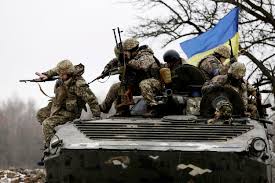Basic Military Lessons from Ukraine War: Bombers, Russia Conduct.Massive ‘Wave Attack’ On Airbase To Tame Ukraine

By Vijainder K Thakur- August 6, 2023
In the early morning hours of August 6, 2023, Russia struck Ukraine’s Starokonstantinov (Староконстантинов) Air Base near Starokostiantyniv, Khmelnytskyi Oblast.
The airbase hosts the 7th Tactical Aviation Brigade flying Sukhoi Su-24M and Sukhoi Su-24MR. The Su-24MR is the launch platform for the near identical British Storm Shadow and French Scalp long-range cruise missiles, using which Ukraine periodically strikes painful blows on Russia.
The attack followed a Ukrainian strike on a civilian oil tanker with a maritime kamikaze drone carrying explosives equivalent to 450 kg of TNT on the night of August 5.
As a result of the drone strike, the engine room of the tanker, which was in close proximity to the Kerch bridge, was flooded. However, it was possible to tow the tanker to safety. The crew was unharmed.
Multiple Wave Attack
The Russian attack on Starokonstantinov was executed in multiple waves.
The first wave comprised cruise missiles launched by Tu-95MS bombers and ballistic missiles.
The second wave comprised cruise missiles and Geran-2 drones.
The final wave comprised Kh-101 long-range stealth cruise missiles.
The attacking cruise missiles skirted the Ukrainian AD systems and followed a devious route to their target.
When attacking an important target with multiple missiles, Russia often includes decoys to facilitate the detection and geolocation of Ukrainian air defense systems and then attacks the air defense systems with ballistic missiles.
It’s believed that the missile attack on the Starokonstantinov airbase was the largest ever Russian missile attack on any single target.
Hits in the airbase area were reportedly recorded by American satellites at 2.31 Moscow time. At 3.22, there was an additional fire, possibly as a result of detonation.
Based on the location of the hits, it appears that Russia was targeting maintenance support facilities and/or missile stocks, as well as Su-24MR launch platforms.
Su-24 Storm Shadow
Su-24 Aircraft
Ukraine’s Attacks Cross The Red Line
The fury of the Russian attack was likely provoked by Ukraine’s increasing belligerence fueled by the frustration from its faltering counter-offensive. Until recently, Ukraine limited the use of Storm Shadows to targets in Russia’s newly acquired former Ukrainian territories.
On June 22, however, Ukraine crossed a redline when two of its Storm Shadow missiles struck the Chongar and Sivash bridges connecting Crimea and the Kherson region.
On July 19, Ukraine struck an ammunition depot south of an airfield in East Crimea. The strike was Ukraine’s first Storm Shadow strike on Crimea.
On July 2t In the morning, Ukrainian formations again launched several strikes with Storm Shadow missiles in Crimea. A repair point of Russian equipment near the village of Kremnevka near Simferopol came under fire.
Ukraine has struck Crimea with Storm Shadow missiles three more times till date.
On July 29, a Storm Shadow missile attack rendered the railway track on the Chongar Bridge connecting the Kherson region with Crimea unusable.
Spreading Russian Defences Thin
There is a good military reason for Ukraine to widen the scope of its Storm Shadow missile targeting – to spread Russian defenses thin!
The battlefront with Russia’s new territories is limited (around 1000 km wide), and the airspace is heavily contested by capable Russian echeloned AD systems. Besides, Russia has tweaked the AD systems deployed in the area to exploit Storm Shadow vulnerabilities.
When attacking Crimea, Storm Shadow missiles can skirt Russian defenses, fly low over the sea to evade detection. Using data from airborne US/NATO ISR assets, the missiles can skirt ship-borne AD systems.
Russian AD systems deployed in Crimea have likely not been upgraded to deal with Storm Shadow missiles. Through attacks on Crimea, Ukraine has made the battlefront much wider and extremely difficult to defend.
Past Russian Strikes On Starokonstantinov Airbase
Aware of the destructive potential of the Storm Shadow and Scalp Missiles, Russia has repeatedly attacked the Starokonstantinov airbase in the past with the aim of destroying Storm Shadow missile stocks, maintenance facilities, and launch platforms.
Prior to the strike on August 6 night, Russia repeatedly struck the Starokonstantinov Airbase.
It last struck the airbase on the night of July 26 with cruise and Kinzhal missiles. The missile attack was followed up with attacks by Geran-2 kamikaze drones
Russia earlier struck the airbase on the night of June 23. According to the Russian MoD (RuMoD), “Russian Aerospace Forces launched long-range, precision strike missile salvo at an AFU foreign-made hardware and weapons depot.
“The assigned target has been destroyed. The goal of the strike has been achieved,” said the RuMoD.
The strike was likely aimed at missile stock and maintenance equipment to support Storm Shadow operations.
Still earlier, on May 29, 2023, also Russia struck the airbase. On that occasion, Ukrainian sources admitted that five aircraft and fuel & ammunition depots were put out of action; the runway was seriously damaged.
Russian attacks on Starokonstantinov airbase have failed to eliminate the threat from Storm Shadow and Scalp missiles. The attacks have invariably resumed, usually with the same intensity as earlier.
su-24
Su-24 with Storm Shadow Missile
Why Russia Has Not Succeeded?
There are some good reasons why Russia has not succeeded in eliminating the Storm Shadow threat.
Ukraine has hours of warning of an impending attack, allowing flight-worthy Su-24MR to relocate to another base or simply get airborne and move out of harm’s way.
Ukraine has a lot of hardened shelters at the airbase. More than enough to accommodate its operational fleet of Su-24MR
It’s likely that the Ukrainian Air Force moves around its out-of-service Su-24M on the base to complicate target selection
UK and France have large stocks of the missiles
Adequate Warning Time
Very soon after Russian bombers, such as the Tu-95MS and Tu-22M3, armed with cruise missiles takeoff, they start to be tracked by US SBIRS constellation satellites which can detect the hot exhaust of their engines.
US/NATO airborne ELINT assets, manned and unmanned, such as the RC-135 and MQ-9 respectively, can detect their signal emissions from the bombers.
When the bombers launch their cruise missiles, the cruise missiles start to be tracked. As the missiles move Westward towards their target in Ukraine, US/NATO AWACS, on 24×7 patrol over the Black Sea, starts to track the missiles, relaying tracking data to radars and air defense (AD) systems deployed all over Ukraine.
At Starokonstantinov airbase, the warning time of a possible cruise missile strike easily exceeds one hour. However, it’s not practical for the airbase to stop operations and go into a defensive mode immediately following the launch of Russian bombers or the release of cruise missiles.
It’s likely that defensive measures are triggered based on the proximity and flight path of incoming Russian cruise missiles.
Russian Tactics To Reduce Warning Time
In order to keep Ukrainians guessing, Russian cruise missiles change their tracks dramatically. More significantly, Russia mixes its cruise missile attacks with ballistic missile (Iskander-M, Kinhzal) attacks.
Iskander Ballistic missile
File Image: Iskander Ballistic missile
The high speed of the Iskander-M missile, which, unlike a jet-engined cruise missile, is rocket-powered, reduces warning time. The Iskander-M cruises at high supersonic speed and is hypersonic during its end game. The missile also follows a quasi-ballistic trajectory reducing its radar detection range and making its flight path unpredictable.
The MiG-31K launched Kinzhal also minimizes warning time. The missile is more destructive than the Iskander-M and cannot be intercepted by US Patriot AD systems deployed in Ukraine. (Under favorable conditions, it’s possible for a Patriot system to intercept the Iskander-M.)
The problem with the Kinzhal missile is that its launch can be anticipated with the take-off and climb to the height of a MiG-31K armed with the missile!
Hardened Shelters At Starokonstantinov
Ukraine’s Starokonstantinov airbase is well-equipped and defended. Satellite imagery of the base reveals a vast dispersal area with an estimated 40 hardened shelters.
In September 2021, the airfield was reportedly certified according to NATO standards. Assistance in modernization and reconstruction was provided by the United States. As part of the work, the airfield was re-equipped, navigation equipment was installed, and the runway was repaired.
Destroying an aircraft within a hardened shelter can only be done with a pinpoint hit of a large high-speed missile featuring a heavy penetrating warhead. Russia has several short-range air-launched missiles that could do the job, but it does not have the air superiority essential to safely bring the launch platforms within launching range.
To attack aircraft in hardened shelters, Russia has to rely on its tactical ballistic missiles.
Considering that the number of Su-24MR aircraft capable of launching Storm Shadow missiles in Ukrainian Air Force inventory (estimated to be 8) is significantly less than 40, striking at the hardened shelters with Kinzhals and Iskander-M to destroy a Su-24MR would be akin to playing very high stakes Russian roulette.
Target, Target Everywhere, But Not One To Strike
It’s likely that the Ukrainian Air Force moves around its out-of-service Su-24M on the base to make target identification near impossible.
In 2011, the Ukrainian Air Force was estimated to have one regiment (2 or more squadrons) of Su-24M and two squadrons (12-24 aircraft) of Su-24MR. Current Su-24MR strength, according to Wikipedia, is eight aircraft. (This, of course, could be planted disinformation)
As such, Ukraine likely has ten dummy Su-24M/Su-24MR airframes for every operational Su-24MR. All the junk and Christmas Tree spare parts airframe can easily be made to appear like an operational Su-24MR.
Russian satellite imagery analysts need to wade through a lot of clutter if at all they have a way of identifying an operational aircraft.
Large Available Stocks
Both the UK and France have relatively large stocks of the Storm Shadow and Scalp missiles, respectively. It’s likely that the Ukrainian missile stock on Starokonstantinov is well dispersed. As such, Russian strikes, even when successful, fail to produce perceptible results.
Conclusion
Peer-to-peer conflicts rarely involve dramatic triumphs. Ukraine has a formidable capability in the form of the Storm Shadow / Scalp missiles. A capability that it will not easily let go backed to the hilt with technology and expertise from the US and NATO.
It’s unlikely that Russia will be able to eliminate the capability. At best, it will be able to periodically erode it and thereby minimize the threat posed by the missiles.
Vijainder K Thakur is a retired IAF Jaguar pilot. He is also an author, software architect, entrepreneur, and military analyst.



